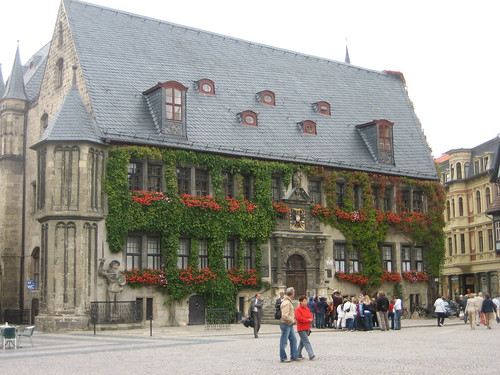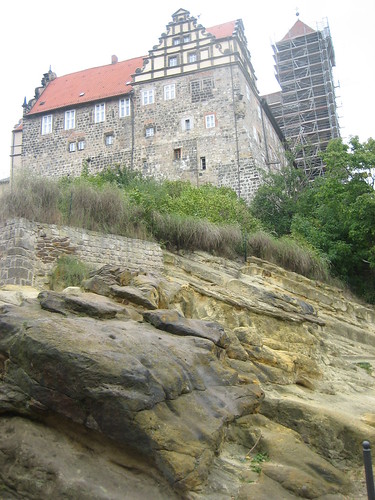 After three nights in Wernigerode, Kelly and I made an afternoon stop at Quedlinburg on our way back to Berlin. This town on the north-eastern edge of the Harz was one of the reasons I had wanted to come to Germany in the first place. I was struck by this passage in Resisting Hitler, a biography of the American scholar, communist, and German resistance member Mildred Harnack-Fish:
After three nights in Wernigerode, Kelly and I made an afternoon stop at Quedlinburg on our way back to Berlin. This town on the north-eastern edge of the Harz was one of the reasons I had wanted to come to Germany in the first place. I was struck by this passage in Resisting Hitler, a biography of the American scholar, communist, and German resistance member Mildred Harnack-Fish:A romantic and evocative region abounding in medieval cathedrals and squares, the Harz has many literary associations, particularly with Heine and Goethe. On a postcard to Falk, Mildred wrote that "the beauty of the mountains, the rivers and forests under the great sun is powerful...Every evening we read Faust I together. It fits these surroundings." Mildred particularly liked Quedlinburg, with its schloss and Romanesque cathedral perched on a sandstone cliff. But it was the wild grandeur of the valley of the Brocken, with granite slopes that bore names like the "Witches Washbasin," "Devil's Pulpit," and finally the "Witches' Dancing place"—where each year on the Witches' Sabbath, Walpurgis Night, the spirits gathered—that formed the romantic backdrop for their nightly readings. "You can only appreciate the landscape of the Harz if you go by foot as Goethe has done," she enthused on a postcard to her mother-in-law.Mildred Harnack-Fish was a member of the so-called Red Orchestra, a group of pro-Soviet/anti-Nazi Germans who attempted radio contact with Moscow. (Harnack-Fish had met her husband at the University of Wisconsin, and returned with him to Germany.) Because many of them had joined the Nazi party and held influential positions in government, they had loads of intelligence to share with the Soviets. For the most part, though, their contacts in Moscow were too inept to make use of it, and of course the Gestapo had intercepted the messages anyway. The round-up began at the end of August 1942, and Mildred and Arvid Harnack were arrested while on holiday at a lake north of Berlin. She was beheaded by the Nazis in February 1943—the only American woman Hitler personally ordered put to death. Shareen Blair Brysac's biography is excellent.
Anyway, when we first arrived in Quedlinburg I wasn't quite as enthused as Mildred was, but that was only because we'd arrived by train and the Quedlinburg train station is pretty gross. (No one had emptied the trash receptacles in quite some time, and there was rubbish all over the floor. The place was run-down in general, and contrary to Lonely Planet's report, there weren't any lockers where we could stash our packs.)
Once we got into town, though, our opinion of the place improved. The center of Quedlinburg is just as atmospheric and charming as Wernigerode's, and the Schloss and Cathedral (the Lutheran Church of St. Servatius) are well worth a visit (the treasury has a strange wartime history of its own—see the Quedlinburg Art Affair, in which an American army lieutenant absconded with many of these treasures that had been hidden in a mine-shaft for safekeeping.)
And of course, there were more of those quaint half-timbered townhouses slanting at weird angles:

And here are a few shots of the Rathaus (Town Hall), the church and castle on the aforementioned sandstone cliff, and a cute picture of my dear travel buddy on the castle terrace overlooking the town:


 Next up in my Germany photo series is the East Side Gallery, but I'll be blogging about my weekend in Sligo first.
Next up in my Germany photo series is the East Side Gallery, but I'll be blogging about my weekend in Sligo first.

2 comments:
Why is the roof slanted so crookedly? Does it help the rain run off better or is it just for aesthetic purposes?
hey Kate...I'm pretty sure all these crooked houses weren't actually meant to lean. No spirit levels in those days!
Post a Comment